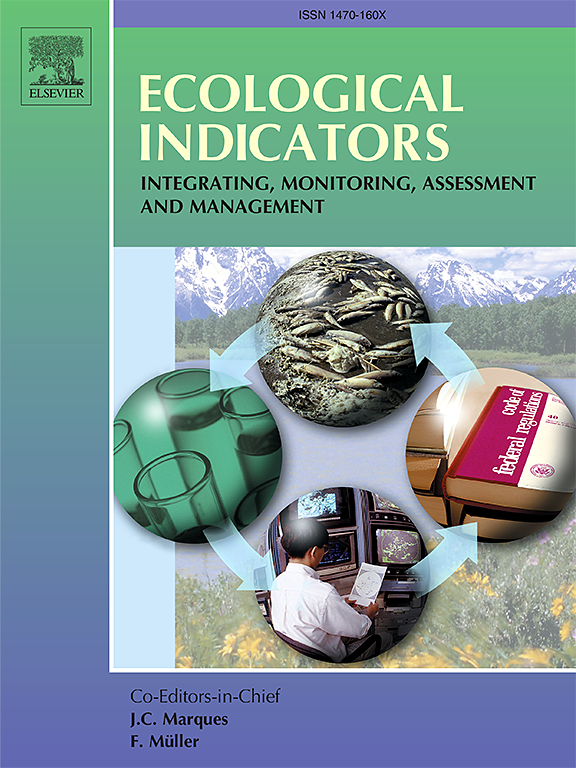分析气候和非气候对喜马拉雅西部森林结构、物候和功能的影响
IF 7
2区 环境科学与生态学
Q1 ENVIRONMENTAL SCIENCES
引用次数: 0
摘要
喜马拉雅森林受到气候和非气候因素的严重威胁,导致生态平衡发生重大变化。本研究通过对近30年来发表的614篇以scopus为索引的论文进行系统分析,分析了西喜马拉雅森林生态系统的主要生态特征和威胁。松树林的树木密度最高,为153至1,675棵/公顷,而班吉橡树林的密度为250至1,500棵/公顷。Moru栎林的最大地上生物量为500 ~ 989 Mg/ha,最大碳储量为30 ~ 445 Mg/ha。气候变化促进了入侵物种在该地区的扩散,威胁到当地的生物多样性。入侵物种如大绒蒿和紫茎Ageratina adenophora表现出广泛的海拔适应性。人类活动和气候变化导致的火灾事件越来越多,这是对森林的另一个主要威胁。气候变化对该地区物候变化的显著影响,如杜鹃和杨梅的早开花早结果,以及树线向上移动。这些影响突出了在该地区开展综合研究以制定有效的适应战略和保护措施的必要性。基于对当前威胁下森林生态系统的深入生态理解的可持续管理实践将促进西喜马拉雅地区基于关键生态系统的方法的保护和确定。本文章由计算机程序翻译,如有差异,请以英文原文为准。
Analyzing climatic and Non-Climatic impacts on Structure, phenology and functions of Western Himalayan forests
The Himalayan forests are critically threatened by climatic and non-climatic drivers, resulting in significant alterations in the ecological balance. This study attempted to analyze the key ecological features and threats to the west Himalayan Forest ecosystem by systematically analyzing 614 Scopus-indexed articles published over the last three decades. Pine forests exhibit maximum tree densities, ranging from 153 to 1,675 trees/ha, while Banj oak forests demonstrate densities of 250 to 1,500 trees/ha. Moru Oak forests possess maximum aboveground biomass ranging from 500-989 Mg/ha, and maximum carbon stocks of 30–445 Mg/ha. Climate change has facilitated the proliferation of invasive species in the region, threatening native biodiversity. Invasive species like Lantana camara and Ageratina adenophora display broad altitudinal adaptability. The increasing number of fire incidents driven by human activities and climate change is another major threat to forests. Multiple reports of phenological shift such as early flowering and fruiting in Rhododendron arboreum and Myrica esculenta, and upward treeline shifts, are visible impacts of climate change in the region. These impacts highlight the necessity for integrated research to develop effective adaptation strategies and conservation measures in the region. Sustainable management practices based on an in-depth ecological understanding of the forest ecosystem under the prevailing threats will facilitate the conservation and identification of critical ecosystem-based approach (EbA) in the western Himalaya.
求助全文
通过发布文献求助,成功后即可免费获取论文全文。
去求助
来源期刊

Ecological Indicators
环境科学-环境科学
CiteScore
11.80
自引率
8.70%
发文量
1163
审稿时长
78 days
期刊介绍:
The ultimate aim of Ecological Indicators is to integrate the monitoring and assessment of ecological and environmental indicators with management practices. The journal provides a forum for the discussion of the applied scientific development and review of traditional indicator approaches as well as for theoretical, modelling and quantitative applications such as index development. Research into the following areas will be published.
• All aspects of ecological and environmental indicators and indices.
• New indicators, and new approaches and methods for indicator development, testing and use.
• Development and modelling of indices, e.g. application of indicator suites across multiple scales and resources.
• Analysis and research of resource, system- and scale-specific indicators.
• Methods for integration of social and other valuation metrics for the production of scientifically rigorous and politically-relevant assessments using indicator-based monitoring and assessment programs.
• How research indicators can be transformed into direct application for management purposes.
• Broader assessment objectives and methods, e.g. biodiversity, biological integrity, and sustainability, through the use of indicators.
• Resource-specific indicators such as landscape, agroecosystems, forests, wetlands, etc.
 求助内容:
求助内容: 应助结果提醒方式:
应助结果提醒方式:


